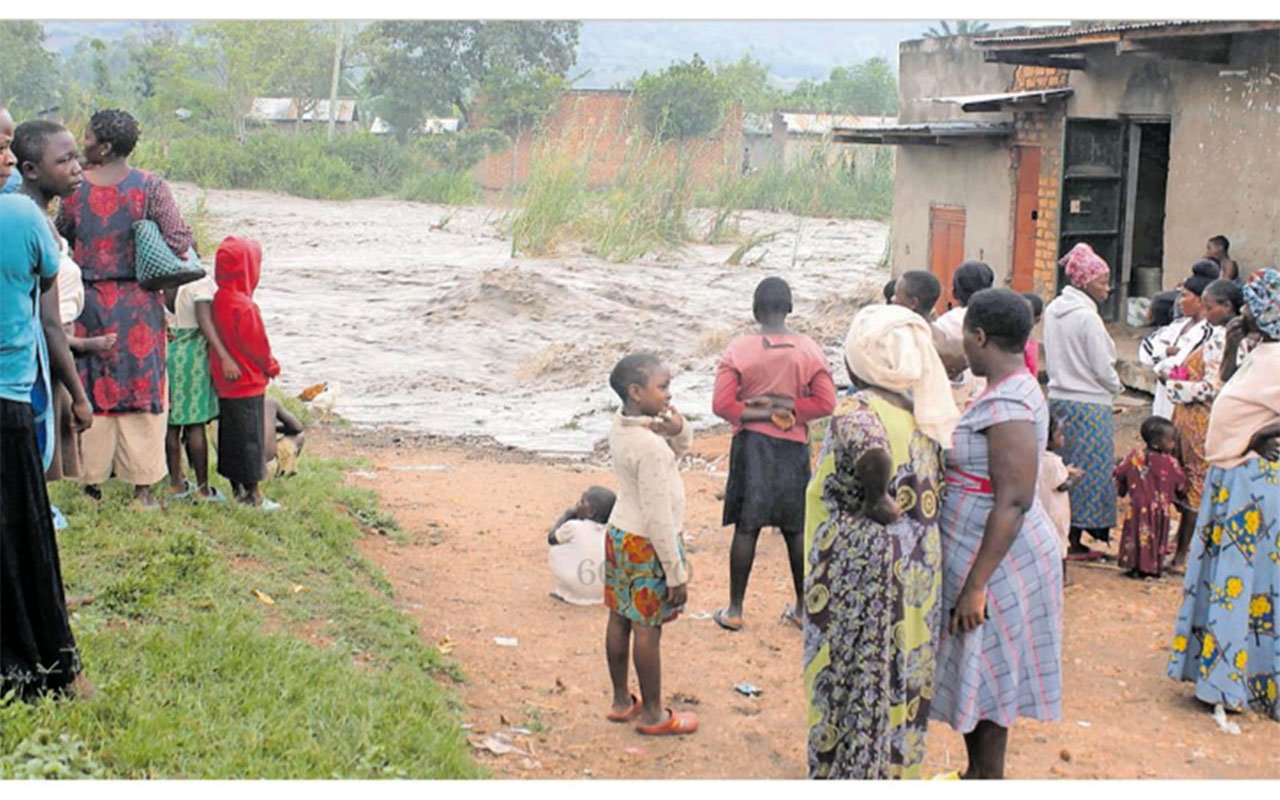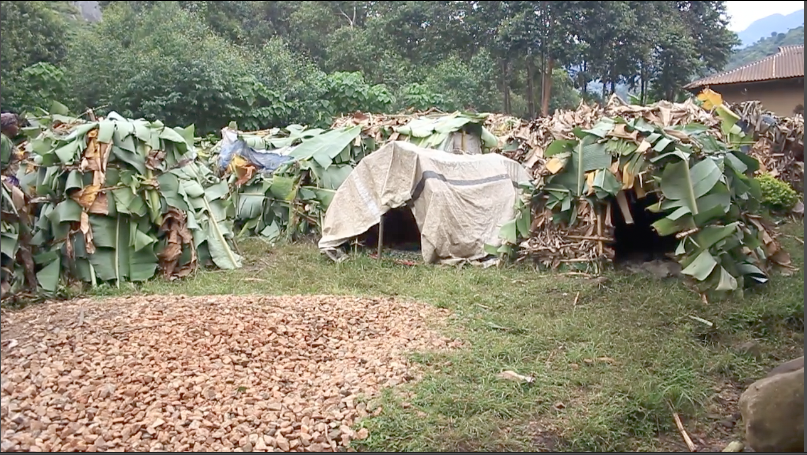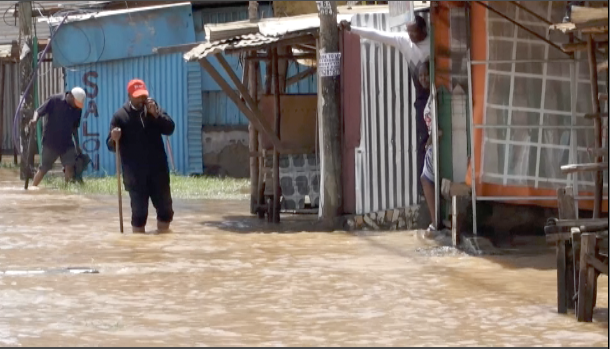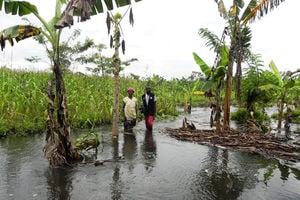
Residents stranded after floods that followed River Nyamwamba’s bursting its banks cut off the access road to their homes in Kasese Town on September 7, 2024. PHOTO/ALEX ASHABA
Despite several government interventions to stop recurring disasters in the Rwenzori Sub-region, several measures seem to have failed to provide permanent solutions to disasters such as flash floods, mudslides, and landslides, which continue to claim lives of people and destroying properties worth millions.
In the last three months (from May), 15 people have died in disasters in Kasese District alone.
To tackle the recurrent cases of flash floods, the government focused on restoration measures around River Nyamwamba, which usually bursts its banks during the rainy season, and its catchment areas.
The government sunk Shs17b into desilting 5.4km hotspot areas along the river, including Masule, Kyanjuki, and Kyanjuki camp (Namuhuga and Kyonjojo). The works commenced in June 2022.
But the works, which involved the maintenance of earthwork, putting gabion masonry, and establishment of a dyke were affected by floods on April 23, 2023 and June 22, 2023 that led to the fresh deposition of silt and boulders within the desilted river channel.
These were emergency mitigation measures against damage to critical infrastructure and loss of livelihoods, according to Dr Emmanuel Brian Guma, the team leader at Albertine Water Management Zone under the Ministry of Water and Environment, which undertook the works.
Tackling flooding
Also, another Shs13 billion was in 2021 released to implement different interventions along the river catchment areas to mitigate the impact caused by floods.
All the funds were secured by the Ministry of Water and Environment as a bank loan from the World Bank. The implementation of the different restoration activities was conducted by different development partners, including Natural Resources Defense Initiative [NRDI] in the upstream part of the river, and Mubuku Integrated Farmers Association and World Wide Fund for Nature.
The interventions included river bank stabilisation, planting bamboo trees on a 30km-stretch along the river, establishing mini-irrigation, re-afforestation, and soil and water conservation activities.
Around March, all these projects were commissioned by the Minister of State for Water, Ms Aisha Sekindi, who said the local people need to embrace alternative sources of income and avoid degrading the river banks with human activities to allow the river to be restored.
However, Kasese has continued to have persistent disasters, primarily caused by heavy rains, which soak the volcanic soils in the Rwenzori Mountain ranges.
On Saturday, September 7, floods hit about 13 villages in Kasese Town after River Nyamwamba burst its banks, leaving two people dead. The floods severely affected residents of Nyamwamba Division, Kasese Municipality.
Rwenzori East Police spokesperson Nelson Tumushiime said the bodies of a man and a woman were retrieved from different locations and that both victims were swept away by the floodwaters as they attempted to cross the flooded areas.
The deceased were identified as Masika Teopista, 40, a nurse at Canope Medical Centre, and Bright Mumbere, 28, an employee at a washing bay in Delta, Kasese Municipality.
The recent floods that affected Kasese Town affected several villages, including Kitoro Cell, Acholi Quarters, Mumbuzi, Base Camp Lower, Kizungu, Nyakasanga West, Kisanga A, Kisanga B, Salute A, Salute B, Kamulikwizi, Kikonzo, and Kisagazi where more than 500 households were affected.
The May mudslides occurred in the mountainous sub-counties of Kitholhu, Ihandiro, Kyondo, Kyarumba, Mahango, Nyakiyumbu, Kisinga, Nyakabingo, and Maliba.
Many residents in the Rwenzori Sub-region, particularly Kasese District, continues to live in disaster-prone areas.
Kasese Municipality Mayor Chance Kahindo attributed the recurring floods, especially in Kasese Town, to the construction of houses in water channels over the years.
"People have built-in water channels, and now, whenever the water rises, their houses get submerged," he said.
Mr Kahindo said to avoid losing more lives, local leaders now need to compel residents whose homes are in these high-risk areas to vacate.
"If they don't leave, people will continue losing their lives and property. The next step is to issue notices to those living in water channels so they can start relocating,"
Mr Kahindo said they previously erected metallic poles to mark the boundary of Kamurikwizi river channel, only for residents to remove them and build their homes in the same area.
“People tamper with riverbanks without notifying leaders, but when floods hit, they rush to us for help. Many people are now residing in these water channels, and they need to leave. So far, we've been fortunate that floods have occurred during the day, but if it happens at night, the death toll could be higher," he said.
Initially, approximately 70 percent of Kasese Town's land was part of the Nyamwamba River's expansive valley. Over time, rapid population growth and land pressure led residents to encroach upon the river's natural course, confining it to narrower passages.
Other people attributed the problem to population pressure on land, and Kasese has registered 22 percent population growth, from 694,987 in 2014 to 847,027, people according to the recently released preliminary results of the National Population and Housing Census of 2024.
Mr Pimako Kasereka, the Nyamwamba Division chairperson, said in the past, the government's efforts have predominantly focused on the upper section of the river and neglecting the lower areas, thereby exacerbating the suffering of residents, including those still displaced since the devastating floods of 2020.
"It is almost four years of unfulfilled promises by the government to resettle the affected families. Many have returned to their flood-prone homes out of frustration.
The Kasese District Chief Administrative Officer, Mr Elias Byamungu, said temporary measures are being undertaken to address the problem, including redirecting the river to its original channel.
"We have hired a D10 Machine from Mbarara City to temporarily redirect the river back to its original channel," he disclosed.
However, Mr Byamungu said there is a need for long-term planning, advocating for the creation of a wider water channel that can accommodate increased water volumes during flooding periods by constructing adequate bridges as crucial steps to safeguarding Kasese Town.
Ms Jane Muhindo, a resident of Kitooro Cell in Kasese Town, highlighted the growing scarcity of land and the increasing population, suggesting that people may need to be relocated forcibly to other areas.
"People cannot easily leave the river banks; many homes are situated near the river. The river's channel has been disrupted, necessitating the provision of alternative land for those living near river banks to facilitate restoration efforts. Otherwise, fatalities will continue to occur whenever flooding happens," she said.
Effect on road infrastructure
In July, in an interview with Monitor, the Kasese District engineer, Mr Alphonce Katswamba, said because of disasters, most roads and bridges have become non-motorable in different sub-counties and the district is need of urgent funds for rehabilitation.
“Almost 80 percent of our road networks have a lot of gullies, and most of the drainage works like culverts are blocked due to the high silt from the mountainous areas,” Mr Katswamba explained.
He identified the most affected road networks as being in the sub-counties of Kyarumba, Bwesumbu, Mbunga, and Kyondo, where he said more than 147kms of the 3,066kms of road network in Kasese District are impassable.
Some of the roads that need rehabilitation include the Mubuku-Karusandara-Prisons Road (21.7 km), Katiri-Kibandama-Kabwarara Road (17 km), Ssebwe Amco Culvert Crossing in Kinyayobyo-Karusandara, Katoke-Ndughutu Bridge, Rwapapara Steel Armco Culvert, Kasenyi Motorable Timber Bridge, Bughendero Motorable Timber Bridges, and Korukukmi Motorable Timber Bridge.
Other roads requiring repairs include Kyoho Bridge, Kamughobe Bridge, Mbunga-Nyakazinga-Karongo-Kasika Road (21.5 km), Bwera-Kibirigha-Ihandiro Road (6.5 km), Bugoye-Muramba-Kisamba Road (6.5 km), Kyondo-Ibimbo Road (8km), and Kaghema-Nyarwanika-Kihungamiyagha Road (6.5 km).




